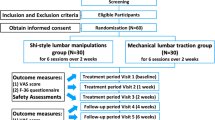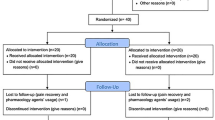Abstract
Objective
To assess the efficacy and safety of Bushen Huoxue Formula (BSHXF) for the treatment of discogenic low-back pain (DLBP).
Methods
This was a parallel, double-blind, randomized, clinical trial performed between May 2019 and June 2020. Seventy patients were assigned by computerized random number table to the treatment group (lumbar traction and BSHXF, 35 cases) or the control group (lumbar traction and placebo, 35 cases). The patients received intervention for 3 weeks. Assessment was conducted before treatment and at week 1, 2, 3 during treatment. Primary outcome was the self-reported score of Oswestry Disability Index (ODI). Secondary outcomes included Visual Analog Scale (VAS), clinical efficacy rate by minimal clinically important difference (MCID) as well as lumbar tenderness, muscle tone and lumbar spine mobility. Adverse reactions were recorded. Follow-up was performed at 1 and 3 months after the end of treatment.
Results
In the treatment group, ODI score was significantly decreased compared with baseline (P<0.05) and the control group at 2- and 3- week treatment. Similarly, VAS score decreased compared with the baseline (P<0.05) and was lower than that in the control group at 2- and 3- week treatment (P<0.05). The clinical efficacy rate of the treatment group was higher than that of the control group after treatment [32.35% (11/34) vs. 3.13% (1/32), P<0.05). Moreover, the tenderness, and muscle tone, as well as the back extension and left flexion in lumbar spine mobility in the treatment group at 3-week treatment were significantly improved compared with the control group (P<0.05). Follow-up showed that at 1-month after treatment, the treatment group had better outcomes than the control group with regard to a total score of ODI and VAS scores, as well as clinical efficacy rate (all P<0.05). Moreover, VAS score was still significantly lower than the control group at 3-month follow-up (P<0.05). No adverse reactions were reported during the study.
Conclusion
BSXHF combined with lumbar traction can significantly improve the clinical symptoms including pain intensity, functionality, muscle tone, and lumbar spine mobility in DLBP patients. (Registration No. ChiCTR1900027777).
Similar content being viewed by others
Data Availability
All data analyzed during this study are included in the manuscript. The raw data used and analyzed during the study are available from the corresponding author upon reasonable request.
References
Collin EC, Kilcoyne M, White SJ, Grad S, Alini M, Joshi L, et al. Unique glycosignature for intervertebral disc and articular cartilage cells and tissues in immaturity and maturity. Nature 2016;3:23062.
Fujii K, Yamazaki M, Kang JD, Risbud MV, Cho SK, Qureshi SA, et al. Discogenic back pain: literature review of definition, diagnosis, and treatment. JBMR Plus 2019;3:e10180.
Lawson LY, Harfe BD. Developmental mechanisms of intervertebral disc and vertebral column formation. Wiley Interdiscip Rev Dev Biol 2017;6:283–297.
Carragee EJ, Hannibal M. Diagnostic evaluation of low back pain. Orthop Clin North Am 2004;35:7–16.
Yang HL, Ma HS, Wang GL, Jiang DH, Zhou J, Zhu RF, et al. Summary of the National Symposium on lumbar degenerative diseases. Chin J Orthop 2006;26:711–716.
Zhu LG, Zhan JW, Feng MS, Wang SQ, Zhang P, Yu J, et al. Clinical observation on treatment of discogenic low back pain by Bushen Huoxue Decoction. World Chin Med (Chin) 2017;12:554–557.
Zhan JW, Feng MS, Zhu LG, Zhang P, Yu J. Effect of static load on the nucleus pulposus of rabbit intervertebral disc motion segment in an organ culture. Biomed Res Int 2016;2016:2481712.
Yang S, Li L, Zhu L, Zhang C, Li Z, Guo Y, et al. Bu-Shen-Huo-Xue-Fang modulates nucleus pulposus cell proliferation and extracellular matrix remodeling in intervertebral disk degeneration through miR-483 regulation of Wnt pathway. J Cell Biochem 2019;120:19318–19329.
Fischgrund JS, Montgomery DM. Diagnosis and treatment of discogenic low back pain. Orthop Rev 1993;22:311–318.
State Administration of Traditional Chinese Medicine. Diagnostic criteria of traditional Chinese medicine. Bei**g: Medicine Science and Technology Press of China; 2012:201.
Fairbank JC, Pynsent PB. The Oswestry Disability Index. Spine 2000;25:2940–2952.
Shafshak TS, Elnemr R. The Visual Analogue Scale versus Numerical Rating Scale in measuring pain severity and predicting disability in low back pain. J Clin Rheumatol 2021;27:282–285.
Jaeschke R, Singer J, Guyatt GH. Measurement of health status: ascertaining the minimal clinically important difference. Contr Clin Trials 1989;10:407–415.
Bailey CS, Rasoulinejad P, Taylor D, Sequeira K, Miller T, Watson J, et al. Surgery versus conservative care for persistent sciatica lasting 4 to 12 months. N Engl J Med 2020;382:1093–1102.
Weinstein JN, Tosteson TD, Lurie JD, Tosteson AN, Hanscom B, Skinner JS, et al. Surgical vs nonoperative treatment for lumbar disk herniation: the Spine Patient Outcomes Research Trial (SPORT): a randomized trial. JAMA 2006;296:2441–2450.
Goldberg H, Firtch W, Tyburski M, Pressman A, Ackerson L, Hamilton L, et al. Oral steroids for acute radiculopathy due to a herniated lumbar disk: a randomized clinical trial. JAMA 2015;313:1915–1923.
Rahyussalim AJ, Zufar MLL, Kurniawati T. Significance of the Association between disc degeneration changes on imaging and low back pain: a review article. Asian Spine J 2020;14:245–257.
Zdeblick TA. The treatment of degenerative lumbar disorders. A critical review of the literature. Spine 1995;20:126S–137S.
Manchikanti L, Soin A, Benyamin RM, Singh V, Falco FJ, Calodney AK, et al. An update of the systematic appraisal of the accuracy and utility of discography in chronic spinal pain. Pain Physic 2018;21:91–110.
Feng C, Yang M, Lan M, Liu C, Zhang Y, Huang B, et al. ROS: crucial intermediators in the pathogenesis of intervertebral disc degeneration. Oxid Med Cell Longev 2017;2017:5601593.
Hazer DB, Acarbaş A, Rosberg HE. The outcome of epiduroscopy treatment in patients with chronic low back pain and radicular pain, operated or non-operated for lumbar disc herniation: a retrospective study in 88 patients. Kor J Pain 2018;31:109–115.
Wiet MG, Piscioneri A, Khan SN, Ballinger MN, Hoyland JA, Purmessur D. Mast cell-intervertebral disc cell interactions regulate inflammation, catabolism and angiogenesis in discogenic back pain. Sci Rep 2017;7:12492.
Salem KH, Al Sharef B, Ladenburger A, Ohnsorge JA. Diagnostic value of CT discography in unclear radiculopathy. Z Orthop Unfall 2011;149:546–549.
Lu X, Zhu Z, Pan J, Feng Z, Lv X, Battié MC, et al. Traumatic vertebra and endplate fractures promote adjacent disc degeneration: evidence from a clinical MR follow-up study. Skeletal Radiol 2022;51:1017–1026.
Horton WC, Daftari TK. Which disc as visualized by magnetic resonance imaging is actually a source of pain? A correlation between magnetic resonance imaging and discography. Spine 1992;17:164–171.
Bydon M, De la Garza-Ramos R, Macki M, Baker A, Gokaslan AK, Bydon A. Lumbar fusion versus nonoperative management for treatment of discogenic low back pain: a systematic review and meta-analysis of randomized controlled trials. J Spinal Disord Tech 2014;27:297–304.
Bello AI, Quartey J, Lartey M. Efficacy of behavioural graded activity compared with conventional exercise therapy in chronic non-specific low back pain: implication for direct health care cost. Ghana Med J 2015;49:173–180.
Mitchell B, Deckers K, De Smedt K, Russo M, Georgius P, Green M, et al. Durability of the therapeutic effect of restorative neurostimulation for refractory chronic low back pain. Neuromodulation 2021;24:1024–1032.
Schimmel JJ, de Kleuver M, Horsting PP, Spruit M, Jacobs WC, van Limbeek J. No effect of traction in patients with low back pain: a single centre, single blind, randomized controlled trial of intervertebral differential dynamics therapy. Eur Spine J 2009;18:1843–1850.
Zhao L, Manchikanti L, Kaye AD, Abd-Elsayed A. Treatment of discogenic low back pain: current treatment strategies and future options-a literature review. Curr Pain Headache Rep 2019;23:86.
Perera RS, Dissanayake PH, Senarath U, Wijayaratne LS, Karunanayake AL, Dissanayake VHW. Variants of ACAN are associated with severity of lumbar disc herniation in patients with chronic low back pain. PLoS One 2017;12:e0181580.
Qiu XZ, Liu D, Zhang XC, Tan XY, Tang G, Jiang SC. Influence of Bugan Jianyao Fang (Liver-tonifying lumbar-invigorating Decoction) on expressions of MMP-3 and TIMP-1 in rats with lumbar disc degeneration. J Bei**g Univ Tradit Chin (Chin) 2018;24:21–25.
**e F, Wu GB, Yao HY, Feng SH, YJ. Effects of Bushen Huoxue Decoction on β -catenin protein level of Wnt signal pathway in lumbar intervertebral disc degeneration aging model rats. J Hunan Univ Chin Med (Chin) 2018;38:275–279.
Grotle M, Brox JI, Vøllestad NK. Functional status and disability questionnaires: what do they assess? A systematic review of back-specific outcome questionnaires. Spine 2005;30:130–140.
Ostelo RW, Deyo RA, Stratford P, Waddell G, Croft P, Von Korff M, et al. Interpreting change scores for pain and functional status in low back pain: towards international consensus regarding minimal important change. Spine 2008;33:90–94.
Li LH, Li KM, Yang SF, Zhu LG, Wang SQ, Chen M, et al. The effects of Kidney-tonifying and blood circulation-promoting recipes combined with platelet-rich plasma on the mesenchymal stem cells of co-culture system. J Hainan Med Univ (Chin) 2019;25:1521–1525.
Author information
Authors and Affiliations
Contributions
Zhan JW and Li KM contributed equally to this work. Zhu LG designed the study. Li KM, Yin XL, Han T, Zhang P, Tang B, Li LH, Chen M, and Shao CC conducted the experiments. Li KM and Wang SQ composed the manuscript. Feng MS and Wei X plotted the manuscript. Zhan JW, Zhu LG, and Yu J revised the manuscript. All authors approved the final version of the manuscript.
Corresponding author
Additional information
Conflict of Interest
The authors declare that they have no conflicts of interest regarding the publication of this paper.
Supported by National Natural Science Foundation of China (No. 81930118), Central Public Welfare Research Institutes (No. ZZ13-YQ-038), Innovation Team and Talents Cultivation Program of National Administration of Traditional Chinese Medicine (No. ZYYCXTD-C-202003), and National Key R & D Program of China (No. 2021YFC1712800)
Electronic Supplementary Material
Rights and permissions
About this article
Cite this article
Zhan, Jw., Li, Km., Zhu, Lg. et al. Efficacy and Safety of Bushen Huoxue Formula in Patients with Discogenic Low-Back Pain: A Double-Blind, Randomized, Placebo-Controlled Trial. Chin. J. Integr. Med. 28, 963–970 (2022). https://doi.org/10.1007/s11655-022-3505-4
Accepted:
Published:
Issue Date:
DOI: https://doi.org/10.1007/s11655-022-3505-4




